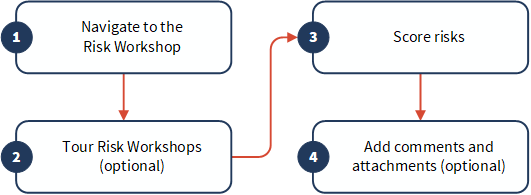Participating in risk workshops
Participate in a collaborative risk assessment hosted by a facilitator.
What is a Risk Workshop?
A Risk Workshop is a platform used for collaborating in a risk assessment process.
How it works
You receive an email from a facilitator that invites you to participate in a Risk Workshop to discuss and score risks associated with specific operating segments.
The scores of all participants are automatically averaged and aggregated into a single risk assessment, and sent to the facilitator to review.
Who participates in a Risk Workshop?
Often, people from different departments within the company participate in a Risk Workshop annually. These people have comprehensive knowledge about their individual areas of the business, and can provide insight into specific business operations.
How long does a Risk Workshop take?
Risk Workshops can vary in length, however, they are generally held over the course of three to five days.
Tips for participating in Risk Workshops
There are some key things you can do to successfully participate in a Risk Workshop.
Understand definitions for scoring criteria
It is important to understand definitions for scoring criteria so that you can appropriately assess risks both qualitatively and quantitatively.
- While scoring a risk, in the Assessments tab, click Risk scoring definitions. If your facilitator has created definitions, you can learn about the exact requirements for each score.
- If you do not understand definitions for scoring criteria, or they are not available, contact your facilitator, or post a comment in the Risk Workshop.
Quantitative example
You need to assess the cost impact of a cash flow risk for the EMEA region.
The scoring labels are "Low," "Medium," and "High." The definitions include a cost impact in dollars that relates to each of the labels:
- Low = $10,000,000 - $49,999,999
- Medium = $50,000,000 - $99,999,999
- High = $100,000,000 +
You assess cost impact as "Medium" for the EMEA region.
Result The cost impact of the cash flow risk for the EMEA region is defined between $50,000,000 - $99,999,999.
Qualitative example
You need to assess the impact of a negative media coverage risk for a department in your company.
The scoring labels are "Low," "Medium," and "High." The definitions illustrate an impact scale for negative media coverage:
- Low = Short-term negative media coverage at the national level.
- Medium = Long-term negative media coverage at the national level, with a loss of market share.
- High = Long-term negative media coverage at the international level, with a significant loss of market share.
You assess the impact of negative media coverage risk as "High" for the department in your company.
Result The impact of the negative media coverage risk is defined as long-term negative media coverage at the international level, with a significant loss of market share.
Initiate conversations
Risk assessments are a collaborative process between participants, and with the facilitator.
For example, you can post comments within the Risk Workshop to discuss your rationale behind risk scoring. If you need to provide additional documentation to support your rationale, you can attach files directly to the Risk Workshop.
Workflow

Steps
Navigate to the Risk Workshop
- Open the Risk Workshop email invitation.
- Within the email, click the Risk Workshop link.
The Risk Workshop opens. If you have access to Diligent One Platform, you are prompted to sign in before you can access the Risk Workshop.
CautionThe link in the email invitation acts like a password that grants you access to the Risk Workshop. To ensure your security and privacy, avoid sharing the link.
Tour Risk Workshops (optional)
- Read the tour notes to familiarize yourself with the Risk Workshop.
- Do one of the following:
- To navigate to the next tour note, click Next.
- To close the tour, click Close.
At anytime, you can restart the tour by selecting the question mark ![]() > Restart workshop tour.
> Restart workshop tour.
Score risks
- Score each area using the 3, 5, 10 point or a custom scale to score each operating segment.
To view the weight of a risk scoring factor, hover your mouse over the name of the risk scoring factor.
- Optional. To clear a score, click the appropriate score and select Clear.Tip
To quickly clear a score, click the appropriate score and press X, Delete, or Backspace on your keyboard.
- Repeat steps 1-3 to assess each risk.
Result Scores are automatically submitted to the facilitator for review. As long as the Risk Workshop is open, you can resubmit scores.
Add comments and attachments (optional)
- From the Risks (#/# Assessed) list, select a risk.
The Assessments tab opens.
- Click the Comments tab.
- Do any of the following:
- Enter a comment in the text box and click Post.Note
You can only edit and delete your own comments. All comments are visible to the facilitator and participants on the Comments tab.
- Drag a file into the designated area, or click Choose files to choose a specific file to upload.
The maximum file size is 1GB.
Note
For security reasons, Diligent One does not accept file attachments with the following extensions: .bat, .com, .dmg, .exe, or .scr.
- Enter a comment in the text box and click Post.
Result Scores, comments, and attachments are automatically submitted to the facilitator for review. As long as the Risk Workshop is open, you can resubmit scores, and add additional comments or attachments, as needed.